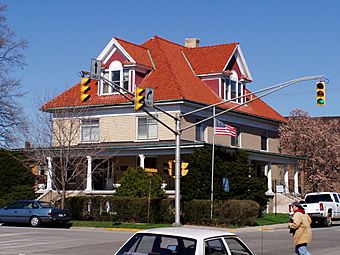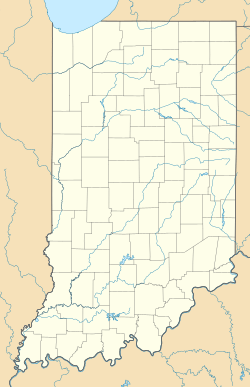Dr. David J. Loring Residence and Clinic facts for kids
Quick facts for kids |
|
|
Dr. David J. Loring Residence and Clinic
|
|
 |
|
| Location | 102 Washington St., Valparaiso, Indiana |
|---|---|
| Built | 1905 |
| Architect | Lembke, Charles F. |
| Architectural style | Colonial Revival |
| NRHP reference No. | 84000520 |
| Added to NRHP | December 6, 1984 |
The Loring Residence and Clinic was a very important building in Valparaiso, Indiana. It was the first place in the town that offered medical services to people. Today, the building is still used for public service by the Valparaiso Woman's Club. Dr. David J. Loring, a doctor and surgeon, used his home as his medical office until he passed away in 1914. He was the first to bring proper medical care to the area and even helped start the first hospital. In 1906, Dr. Loring sold his private hospital building. It then became the county's first public hospital.
Dr. Loring was a skilled physician and surgeon. He was the vice president of the Indiana State Medical Association. He also started the Porter County Medical Society.
Contents
History of the Loring Building
Dr. Loring moved to Valparaiso in 1882. He had studied and practiced medicine in big cities. These included Rush Medical College in Chicago and Bellevue Hospital in New York. He also worked in Cincinnati. Before Valparaiso, he lived in Francesville.
Dr. Loring first opened his clinic and home on Jefferson Street. In 1905, he decided to build a new clinic. This new building was on the corner of Jefferson and Washington Streets. Dr. Loring built his new home in 1906. He used money from selling his first private hospital. He sold it to the Valparaiso Christian Church (Disciples of Christ) for $13,000.
His new home was designed by a local architect. His name was Charles Lembke. When Dr. Loring died in 1914, his home and office were sold. Dr. J. R. Pagin bought it. In 1924, Dr. Pagin sold it to the Elks Club. The Elks Club's own building had burned down that year. However, the Elks decided to rebuild on their old site. They resold the house that same year. The Valparaiso Woman's Club bought it for $30,000.
The building was dedicated to Sarah Porter Kinsey. This happened on September 21, 1925. The Woman's Club paid off their loan for the house. They celebrated this on December 1, 1939. The house was added to the National Register of Historic Places in 1985. This means it is a special historical building. The property is located near the County Courthouse.
Valparaiso Woman's Club and Its Work
The Valparaiso Woman's Club started in 1895. It was a group for reading and social activities. At first, it was called the Ladies Reading Circle. This group helped start a public library. They collected books for it. They also gave the first $25 towards land for the Carnegie Library.
Later, the club changed its name. In 1896, they were called the Harriet Beecher Stowe Reading Circle. Then they became the Harriet Beecher Stowe Club. In 1904, they officially became the Valparaiso Woman's Club. They joined the Indiana Federation of Clubs. They also became part of the General Federation of Clubs.
Building Design and Look
The Loring Residence and Clinic was designed in a special way. The clinic was in the basement. Dr. Loring's family lived on the upper floors. If a patient was too sick to go home, they could stay in a room upstairs. They would be treated there for a few days.
This building has two and a half stories. It is made of brick. It sits on a corner lot in downtown Valparaiso. The building is in the Colonial Revival style. This style often looks like old American colonial homes. It has a hipped roof with three gabled dormers. These are windows that stick out from the roof. There is also a porch with a flat roof. This porch goes across the front and most of the south side.
The front of the building faces west. The basement level is covered with rough stone. This stone goes all around the outside. The basement has simple windows. There are also entrances on the front and south sides. These allow direct access to the basement.
The main level of the front has three sections. The porch covers this area. Round white columns with fancy tops support the porch roof. A black wrought iron railing runs along the edges of the porch. This railing was added later.
Stone steps lead to the main entrance. They have wrought iron handrails. The entrance is in the middle of the front side. It has a wooden door with a window above it. The door is framed by paired columns and flat columns. These support a fancy stone design above. All these parts are made of carved limestone.
Large rectangular windows are on each side of the doorway. They have special glass with patterns. Each window has a limestone top and bottom. All windows on the first floor look like this. All windows on the building now have aluminum storm windows.
On the second floor, there are two large rectangular windows. They are similar to the first-floor windows. But they do not have the fancy stone tops. A wide wooden trim is above these windows. It goes all around the outside of the building.
The south side of the building also faces the street. It has five sections on the main level. It looks similar to the front side. The porch covers about two-thirds of this side. It shelters an entrance like the main one. Narrow windows frame this doorway.
A large window is on the west end of this side. A smaller window is on the east end. On the second floor, three large windows line up with the entrance and end windows below. The north side of the building is simpler. It has a center section that sticks out.
The back of the building has a service porch. A roof covers it. Four round columns support this roof. Two of these columns are attached to the wall.
The main roof is covered in red tiles. The Woman's Club put back the original red tile roof. Before, it had been replaced with an asphalt roof. The roof has a dormer on all sides except the north. The north side has a gabled part that sticks out. Each dormer is finished with wood siding that looks like fish scales. They have three windows. A carved wooden rising sun is above the center window. This design suggests a Palladian style. A red tile gable roof tops each dormer. It has classic roof returns where the red tile rests. A brick chimney is on the east end of the roof ridge.
Images for kids
- Mullins, Lanette, Images of America; Valparaiso – Looking Back, Moving Forward, Chicago, Illinois: Arcadia Publishing, 2002.
- Neeley, George E., City of Valparaiso, A Pictorial History, G. Bradley Publishing, Inc.; St. Louis, Missouri: G. Bradley Publishing, Inc., 1989.
- Porter County Interim Report, Indiana Historic Sites and Structures Inventory, Historic Landmarks Foundation of Indiana, July 1991.






